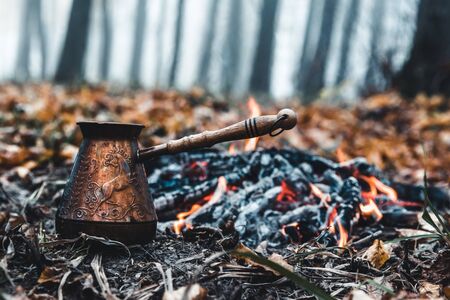Campfire Baking Essentials
When it comes to baking in the wild, preparation is everything. Mastering the art of campfire baking starts with understanding the essentials you’ll need before you even strike a match. Traditional American outdoor culture emphasizes not just resourcefulness, but also the joy of sharing homemade bread or cake under an open sky. Whether you’re aiming for golden skillet cornbread or gooey cinnamon rolls, your toolkit matters. First, invest in a sturdy cast iron Dutch oven—this is the backbone of all successful campfire baking. Pair it with a lid lifter and heat-resistant gloves to keep safety front and center. Don’t forget heavy-duty aluminum foil, which works wonders for makeshift bakes and lining pans. For ingredients, go for all-purpose flour, baking powder, sugar, salt, and shelf-stable fats like ghee or vegetable shortening; these staples hold up well outdoors. Measuring cups and spoons are helpful, but many seasoned campers rely on “eyeballing” quantities—a nod to classic American ingenuity. Lastly, bring along wooden spoons and silicone spatulas for mixing, and pack airtight containers to keep critters away from your dry goods. With these basics ready, you’ll be set to recreate your favorite baked treats right at the campfire, turning any campsite into an outdoor bakery.
2. Mastering the Fire: Heat Control and Safety
Baking over a campfire isn’t just about tossing dough into the flames; it’s an art that starts with mastering your fire. In the U.S., campfire baking means balancing safety, heat control, and flavor to create everything from crusty bread to gooey cinnamon rolls. Let’s break down the essentials for building the perfect baking fire and making sure everyone stays safe around the flames.
Building the Perfect Baking Fire
Not all campfires are created equal—especially when you’re aiming for even heat for baking. The classic American method is to start with dry hardwood like oak or maple, which burns hot and long. Stack your wood in a log cabin or teepee style and let it burn down to glowing coals; this is your secret ingredient for consistent baking heat. Avoid green wood or softwoods, as they can give off too much smoke and unpredictable heat.
Types of Campfire Setups
| Fire Setup | Best For | Pros | Cons |
|---|---|---|---|
| Log Cabin | Bread, cakes, even pizzas | Even heat, stable base | Takes time to build up coals |
| Teepee | Quick heat, boiling water | Fast ignition, easy to start | Less even heat, burns quickly |
| Trench Fire | Baking with Dutch ovens | Concentrated heat, wind protection | Requires digging (check site rules) |
Managing Heat Like a Pro
The difference between perfectly baked cornbread and burnt offerings is all about controlling your fire’s heat. Spread out your coals in a flat bed and adjust their thickness depending on what you’re baking—thin for cakes, thicker for hearty breads. Remember: more coals on top of your Dutch oven means higher temps (think golden crust), while fewer below help avoid scorching. A simple hand test (hold your hand above the coals at cooking height; 5-7 seconds means medium heat) works well when you don’t have a thermometer.
Heat Levels by Hand Test
| Seconds Held Over Coals | Estimated Temp (°F) | Baking Uses |
|---|---|---|
| 2-4 seconds | 450-500°F | Pizzas, flatbreads |
| 5-7 seconds | 375-400°F | Cakes, muffins, quick breads |
| 8-10 seconds | 325-350°F | Scones, soft rolls, slow bakes |
Campfire Safety Best Practices (U.S. Standards)
No matter how tasty that loaf turns out, safety always comes first. Always check local regulations—many U.S. parks require fires only in designated rings or pits. Keep water and a shovel nearby to control stray embers and fully extinguish your fire when done (stir ashes until cool to the touch). Teach kids to stay at least three feet from the fire ring, and never leave your campfire unattended. These habits aren’t just good sense—they’re key to protecting America’s wild spaces for future bakers.
Your Next Steps:
With these basics nailed down, you’re ready to move on to mixing doughs and experimenting with flavors under the stars. Get creative—but keep one eye on those glowing coals!

3. Sourdough and Skillet Breads
If you’ve ever dreamed of pulling a crusty loaf from the coals or flipping golden cornbread in a cast iron skillet, campfire baking is your next outdoor adventure. Baking breads like sourdough, bannock, and cornbread over an open flame doesn’t have to be intimidating. With just a few tools and some easy-to-follow techniques, you can enjoy fresh bread in the wild—no oven required.
Easy Sourdough for the Wild
Sourdough might sound fancy, but it’s actually one of the most forgiving breads to make at camp. All you need is an active starter (which travels well in a mason jar), flour, water, salt, and time. Mix your dough at camp in the morning, let it rise while you hike or fish, then shape and bake it in a Dutch oven buried in embers. The result? Tangy, chewy bread with a smoky crust that rivals any bakery back home.
Bannock: The Ultimate Trail Bread
Bannock is a backcountry classic—a quick bread that needs no yeast and bakes up beautifully on a skillet or even wrapped around a stick. Just blend flour, baking powder, salt, water (and maybe some butter if you’re feeling fancy), pat into rounds, and cook until golden. It’s perfect for breakfast with jam or as a hearty side to stew.
Cornbread Comforts
Few things say “American campfire” like skillet cornbread. Combine cornmeal, flour, eggs, milk (powdered works in a pinch), baking powder, and a dash of sugar right in your pan. Cook over steady coals with the lid on for even heat. Pro tip: Add bacon grease or canned corn for extra flavor and moisture.
Campfire Baking Tips
The key to successful bread baking outdoors is managing your fire’s heat. Use hot coals instead of direct flames for even cooking. Cast iron holds heat well and creates that signature crust—just remember to preheat your pans before adding dough. And don’t worry if your first loaf isn’t perfect; half the fun is experimenting and tasting as you go.
4. Campfire Cakes and Sweet Treats
Nothing says American campfire culture quite like gathering around the fire to enjoy a warm, homemade dessert. Whether you’re celebrating the end of a long hike or just savoring a quiet evening in the woods, baking cakes and sweet treats over an open flame brings people together in the most delicious way. Let’s dive into some classic American campfire desserts that are surprisingly easy to make outdoors—even if you’re not a seasoned baker.
Dutch Oven Cobblers: A Camp Classic
The Dutch oven is a true workhorse for campfire baking, especially when it comes to cobblers. All you need are fresh or canned fruits, a simple batter or biscuit mix, and some sugar. Layer your ingredients in the Dutch oven, cover with the lid, and let the coals do their magic. The result? Gooey, golden-topped cobbler that tastes like home. Here’s a handy reference for favorite combinations:
| Fruit Base | Batter/Biscuit Mix | Optional Add-Ins |
|---|---|---|
| Peach | Cake mix or Bisquick | Cinnamon, brown sugar |
| Berry (blueberry, raspberry) | Cornbread mix | Lemon zest, vanilla |
| Apple | Biscuit dough | Nuts, caramel bits |
Simple Pan Cakes You Can Whip Up Anywhere
If you don’t have a Dutch oven, no worries—a cast iron skillet works wonders for quick cakes right over the coals. Try mixing up pancake batter with a bit of sugar and pouring it into a well-greased skillet. Top with whatever you have on hand: chocolate chips, nuts, marshmallows, or even sliced bananas. Cover loosely with foil and let it bake until set. The edges get crispy while the inside stays soft—almost like a giant cookie meets cake.
S’mores-Inspired Variations
For something truly American, riff on s’mores by folding crushed graham crackers and chocolate chunks into your cake batter. Top with mini marshmallows during the last few minutes of baking so they get golden but not burned. It’s nostalgia in every bite.
Tips for Sweet Success in the Wild
- Keep mixes simple—pre-mix dry ingredients at home to save time.
- Use parchment paper liners in Dutch ovens for easy cleanup.
- Rotate your pan or Dutch oven regularly for even baking.
The beauty of campfire cakes and desserts is their forgiving nature and adaptability—no fancy equipment required, just a little creativity and a taste for adventure.
5. Beyond Bread: Creative Baking in the Wild
If you’re ready to level up your campfire baking game, it’s time to look beyond classic bread. The wild is your test kitchen, and with a little creativity, you can whip up treats that rival your home oven. Imagine biting into a gooey cinnamon roll as morning fog lifts off the lake or sharing fresh-baked cookies under a starlit sky. Campfire baking isn’t just about survival—it’s about savoring new experiences.
Cinnamon Rolls: Morning Comfort, Wilderness Style
For adventurous bakers, cinnamon rolls are surprisingly campfire-friendly. Use pre-made dough or mix flour, sugar, and yeast at camp. Roll out the dough on a floured cutting board (or even a flat rock), sprinkle with cinnamon sugar, then roll it up. Slice and arrange the rolls in a cast-iron skillet, cover with foil, and let them bake over glowing coals. The result? Soft, sticky spirals that fill your campsite with cozy aromas.
Cookies: Sweet Rewards After a Long Hike
Cookies are another crowd-pleaser that adapt well to outdoor baking. Mix cookie dough at home or bring dry ingredients to combine at camp. Drop spoonfuls onto greased foil or directly into a Dutch oven lined with parchment paper. Keep an eye on the heat—campfire cookies bake fast! Experiment with s’mores-inspired add-ins like marshmallows and chocolate chunks for that all-American camping twist.
Pizza: A Slice of Civilization in the Backcountry
Yes, you can make pizza over a campfire! Start with store-bought or homemade dough stretched thin for quicker cooking. Top with tomato sauce, cheese, and whatever toppings you packed—think pepperoni, olives, or even wild-foraged mushrooms if you’re feeling brave. Cook in a skillet covered with foil until the crust is golden and the cheese bubbles. Pizza night in the woods? That’s next-level wilderness living.
Campfire Baking Tips for Adventurous Cooks
- Prep dry mixes at home to save time and weight.
- Pack sturdy pans—cast iron is your best friend for even heat.
- Rotate pans often for uniform baking.
- Cover dishes with foil to trap heat and mimic an oven.
The Joy of Experimentation
The beauty of campfire baking is that there are no hard rules—just plenty of room to experiment and enjoy the process. Whether you’re twisting cinnamon rolls around sticks or improvising a pizza on hot stones, each bake is a story in itself. So next time you head outdoors, bring your curiosity (and maybe some extra chocolate chips) and let your inner baker roam wild.
6. Tips, Troubleshooting, and Cleanup
Time-Saving Tricks for Campfire Baking
When you’re baking bread or cakes in the wild, every minute counts. Prep dry mixes at home in resealable bags to save time at camp. Use parchment paper to line Dutch ovens and pie irons—this makes transferring baked goods easy and cuts down on cleaning. Pre-measure ingredients for quick assembly, and keep a headlamp handy for those dusk-to-dark baking sessions.
Common Campfire Baking Challenges—and How to Solve Them
Uneven Heat
Campfire heat can be unpredictable. Rotate your Dutch oven or pan regularly to avoid hot spots. If things are browning too quickly, raise your bakeware higher above the coals or reduce the number of coals on top.
Soggy Bottoms
To avoid undercooked bottoms, use a trivet or small stones to elevate your Dutch oven slightly off the direct heat. This creates a more even bake and prevents burnt crusts.
Batter Overflow
Bake in batches if necessary—overfilling pans leads to messes and uneven cooking. For cakes and quick breads, fill pans only halfway to allow for rise.
Eco-Friendly Cleanup Practices
Respecting nature is part of the outdoor baking art. Scrape food remnants into a trash bag and pack them out—never bury or burn them. Use biodegradable soap sparingly with a small amount of hot water for washing up. Wipe equipment with reusable cloths instead of paper towels, and let everything air-dry before packing away. Keeping your campfire baking low-impact ensures that the wild stays wild for everyone who comes after you.

